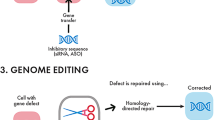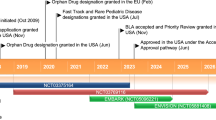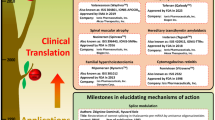Abstract
Duchenne muscular dystrophy (DMD) is an X-linked genetic disease primarily affecting boys causing loss of the dystrophin protein, ultimately leading to muscle wastage and death by cardiac or respiratory failure. The genetic mutation involved can be overcome with antisense oligonucleotides which bind to a pre-mRNA and results in reading frame restoration by exon skipping. Phosphorodiamidate morpholino oligonucleotides (PMOs) are a class of antisense agents with a neutral backbone derived from RNA which can induce effective exon skipping. In this review, the evolution of PMOs in exon skipping therapy for the last two decades has been detailed with the gradual structural and functional advancements. Even though the success rate of PMO-based therapy has been high with four FDA approved drugs, several key challenges are yet to overcome, one being the dystrophin restoration in cardiac muscle. The current scenario in further improvement of PMOs has been discussed along with the future perspectives that have the potential to revolutionize the therapeutic benefits in DMD.








Similar content being viewed by others
References
Aartsma-Rus A 2022 Good news for the mdx mouse community: Improved dystrophin restoration after skipping mouse dystrophin exon 23. Mol. Ther. Nucleic Acids 30 355–356
Aartsma-Rus A, De Winter CL, Janson AA, et al. 2005 Functional analysis of 114 exon-internal AONs for targeted DMD exon skipping: indication for steric hindrance of SR protein binding sites. Oligonucleotides 15 284–197
Aartsma-Rus A, Morgan J, Lonkar P, et al. 2019 Report of a TREAT-NMD/world Duchenne organisation meeting on dystrophin quantification methodology. J. Neuromuscul. Dis. 6 147–159
Agarwal S 2020 High-dose AAV gene therapy deaths. Nat. Biotechnol. 38 910
Akpulat U, Wang H, Becker K, et al. 2018 Shorter phosphorodiamidate morpholino splice-switching oligonucleotides may increase exon-skipping efficacy in DMD. Mol. Ther. Nucleic Acids 13 534–542
Alter J, Lou F, Rabinowitz A, et al. 2006 Systemic delivery of morpholino oligonucleotide restores dystrophin expression bodywide and improves dystrophic pathology. Nat. Med. 12 175–177
Amantana A, Moulton HM, Cate ML, et al. 2007 Pharmacokinetics, biodistribution, stability and toxicity of a cell-penetrating peptide−morpholino oligomer conjugate. Bioconjugate Chem. 18 1325–1331
Anthony K, Ala P, Catapano F, et al. 2023 T cell responses to dystrophin in a natural history study of Duchenne muscular dystrophy. Hum. Gene Ther. 34 439–448
Betts C, Saleh AF, Arzumanov AA, et al. 2012 Pip6-PMO, a new generation of peptide-oligonucleotide conjugates with improved cardiac exon skipping activity for DMD treatment. Mol. Ther. Nucleic Acids 1 e38
Cao L, Han G, Lin C, et al. 2016 Fructose promotes uptake and activity of oligonucleotides with different chemistries in a context-dependent manner in mdx mice. Mol. Ther. Nucleic Acids 5 e329
Carver MP, Charleston JS, Shanks C, et al. 2016 Toxicological characterization of exon skipping phosphorodiamidate morpholino oligomers (PMOs) in non-human primates. J. Neuromuscul. Dis. 3 381–393
Choi E and Koo T 2021 CRISPR technologies for the treatment of Duchenne muscular dystrophy. Mol. Ther. 29 3179–3191
Cirak S, Arechavala-Gomeza V, Guglieri M, et al. 2011 Exon skipping and dystrophin restoration in patients with Duchenne muscular dystrophy after systemic phosphorodiamidate morpholino oligomer treatment: an open-label, phase 2, dose-escalation study. Lancet 378 595–605
Corey DR and Abrams JM 2001 Morpholino antisense oligonucleotides: tools for investigating vertebrate development. Genome Biol. 2 1–3
Crooke ST, Vickers TA and Liang XH 2020 Phosphorothioate modified oligonucleotide–protein interactions. Nucleic Acids Res. 48 5235–5253
Das A, Ghosh A and Sinha S 2023a C5-pyrimidine-functionalized morpholino oligonucleotides exhibit differential binding affinity, target specificity and lipophilicity. Org. Biomol. Chem. 21 1242–1253
Das U, Kundu J, Shaw P, et al. 2023b Self-transfecting GMO-PMO chimera targeting Nanog enable gene silencing in vitro and suppresses tumor growth in 4T1 allografts in mouse. Mol. Ther. Nucleic Acids 32 203–228
Deconinck N and Dan B 2007 Pathophysiology of duchenne muscular dystrophy: current hypotheses. Pediatr. Neurol. 36 1–7
Dongsheng D, Nathalie G, Eugenio M, et al. 2021 Duchenne muscular dystrophy (Primer). Nat. Rev. Dis. Primers 7 1–19
Echigoya Y, Mouly V, Garcia L, et al. 2015 In silico screening based on predictive algorithms as a design tool for exon skipping oligonucleotides in Duchenne muscular dystrophy. PLoS One 10 e0120058
Ferguson DP, Dangott LJ and Lightfoot JT 2014 Lessons learned from vivo-morpholinos: How to avoid vivo-morpholino toxicity. Biotechniques 56 251–256
Fletcher S, Honeyman K, Fall AM, et al. 2006 Dystrophin expression in the mdx mouse after localised and systemic administration of a morpholino antisense oligonucleotide. J. Gene Med. 8 207–216
Fletcher S, Honeyman K, Fall AM, et al. 2007 Morpholino oligomer–mediated exon skipping averts the onset of dystrophic pathology in the mdx mouse. Mol. Ther. 15 1587–1592
Gan L, Wu LC, Wood JA, et al. 2022 A cell-penetrating peptide enhances delivery and efficacy of phosphorodiamidate morpholino oligomers in mdx mice. Mol. Ther. Nucleic Acids 30 17–27
Gao X, Zhao J, Han G, et al. 2014 Effective dystrophin restoration by a novel muscle-homing peptide–morpholino conjugate in dystrophin-deficient mdx mice. Mol. Ther. 22 1333–1341
Gebski BL, Mann CJ, Fletcher S, et al. 2003 Morpholino antisense oligonucleotide induced dystrophin exon 23 skipping in mdx mouse muscle. Hum. Mol. Genet. 12 1801–1811
Goyenvalle A, Babbs A, Powell D, et al. 2010 Prevention of dystrophic pathology in severely affected dystrophin/utrophin-deficient mice by morpholino-oligomer-mediated exon-skipping. Mol. Ther. 18 198–205
Gupta A, Gupta S, Das U, et al. 2022 Guanidinium-functionalized flexible azaproline transporter for efficient intracellular delivery of proapoptotic peptide and PDL1 antisense morpholino oligo in human carcinoma cells in vitro. Bioconjugate Chem. 33 907–917
Han G, Gu B, Lin C, et al. 2019 Hexose potentiates peptide-conjugated morpholino oligomer efficacy in cardiac muscles of dystrophic mice in an age-dependent manner. Mol. Ther. Nucleic Acids 18 341–350
Happi Mbakam C, Lamothe G and Tremblay JP 2022 Therapeutic strategies for dystrophin replacement in Duchenne muscular dystrophy. Front. Med. 9 774
Heemskerk H, De Winter CL, Van Ommen GJB, et al. 2009 Development of antisense mediated exon skipping as a treatment for Duchenne muscular dystrophy. Ann. N. Y. Acad. Sci. 1175 71–79
Hudziak RM, Barofsky E, Barofsky DF, et al. 1996 Resistance of morpholino phosphorodiamidate oligomers to enzymatic degradation. Antisense Nucleic Acid Drug Dev. 6 267–272
Ivanova GD, Arzumanov A, Abes R, et al. 2008 Improved cell-penetrating peptide–PNA conjugates for splicing redirection in HeLa cells and exon skipping in mdx mouse muscle. Nucleic Acids Res. 36 6418–6428
Järver P, Mäger I and Langel Ü 2010 In vivo biodistribution and efficacy of peptide mediated delivery. Trends Pharmacol. Sci. 31 528–535
Järver P, Zaghloul EM, Arzumanov AA, et al. 2015 Peptide nanoparticle delivery of charge-neutral splice-switching morpholino oligonucleotides. Nucleic Acid Ther. 25 65–77
Jearawiriyapaisarn N, Moulton HM, Buckley B, et al. 2008 Sustained dystrophin expression induced by peptide-conjugated morpholino oligomers in the muscles of mdx mice. Mol. Ther. 16 1624–1629
Jearawiriyapaisarn N, Moulton HM, Sazani P, et al. 2010 Long-term improvement in mdx cardiomyopathy after therapy with peptide-conjugated morpholino oligomers. Cardiovasc. Res. 85 444–453
Kundu J, Banerjee P, Bose C, et al. 2020 Internal oligoguanidinium transporter: mercury-free scalable synthesis, improvement of cellular localization, endosomal escape, mitochondrial localization, and conjugation with antisense morpholino for NANOG inhibition to induce chemosensitization of taxol in MCF-7 cells. Bioconjugate Chem. 31 2367–2382
Le BT, Paul S, Jastrzebska K, et al. 2022 Thiomorpholino oligonucleotides as a robust class of next generation platforms for alternate mRNA splicing. Proc. Natl. Acad. Sci. USA 119 e2207956119
Li X, Kheirabadi M, Dougherty PG, et al. 2023 The endosomal escape vehicle platform enhances delivery of oligonucleotides in preclinical models of neuromuscular disorders. Mol. Ther. Nucleic Acids 33 273–285
Li YF and Morcos PA 2008 Design and synthesis of dendritic molecular transporter that achieves efficient in vivo delivery of morpholino antisense oligo. Bioconjugate Chem. 19 1464–1470
Lim KRQ, Woo S, Melo D, et al. 2022 Development of DG9 peptide-conjugated single-and multi-exon skipping therapies for the treatment of Duchenne muscular dystrophy. Proc. Natl. Acad. Sci. USA 119 e2112546119
Malerba A, Boldrin L and Dickson G 2011 Long-term systemic administration of unconjugated morpholino oligomers for therapeutic expression of dystrophin by exon skipping in skeletal muscle: implications for cardiac muscle integrity. Nucleic Acid Ther. 21 293–298
Malerba A, Thorogood FC, Dickson G, et al. 2009 Dosing regimen has a significant impact on the efficiency of morpholino oligomer-induced exon skipping in mdx mice. Hum. Gene Ther. 20 955–965
Mann CJ, Honeyman K, Cheng AJ, et al. 2001 Antisense-induced exon skipping and synthesis of dystrophin in the mdx mouse. Proc. Natl. Acad. Sci. USA 98 42–47
Miyagoe-Suzuki Y and Takeda SI 2010 Gene therapy for muscle disease. Exp. Cell Res. 316(18) 3087–3092
Monaco AP, Bertelson CJ, Liechti-Gallati S, et al. 1988 An explanation for the phenotypic differences between patients bearing partial deletions of the DMD locus. Genomics 2 90–95
Muntoni F, Torelli S and Ferlini A 2003 Dystrophin and mutations: one gene, several proteins, multiple phenotypes. Lancet Neurol. 2 731–740
Nakamura A and Takeda SI 2009 Exon skipping therapy for Duchenne muscular dystrophy. Neuropathology 29 494–501
Nasevicius A and Ekker SC 2000 Effective targeted gene ‘knockdown’ in zebrafish. Nat. Genet. 26 216–220
Novak JS, Hogarth MW, Boehler JF, et al. 2017 Myoblasts and macrophages are required for therapeutic morpholino antisense oligonucleotide delivery to dystrophic muscle. Nat. Commun. 8 941
O’Donovan L, Okamoto I, Arzumanov AA, et al. 2015 Parallel synthesis of cell-penetrating peptide conjugates of PMO toward exon skipping enhancement in Duchenne muscular dystrophy. Nucleic Acid Ther. 25 1–10
Popplewell LJ, Trollet C, Dickson G, et al. 2009 Design of phosphorodiamidate morpholino oligomers (PMOs) for the induction of exon skipping of the human DMD gene. Mol. Ther. 17 554–561
Roberts RG, Coffey AJ, Bobrow M, et al. 1993 Exon structure of the human dystrophin gene. Genomics 16 536–538
Ryder S, Leadley RM, Armstrong N, et al. 2017 The burden, epidemiology, costs and treatment for Duchenne muscular dystrophy: an evidence review. Orphanet J. Rare Dis. 12 1–21
Sarett SM, Werfel TA, Lee L, et al. 2017 Lipophilic siRNA targets albumin in situ and promotes bioavailability, tumor penetration, and carrier-free gene silencing. Proc. Natl. Acad. Sci. USA 114 E6490–E6497
Sazani P, Ness KPV, Weller DL, et al. 2011 Repeat-dose toxicology evaluation in cynomolgus monkeys of AVI-4658, a phosphorodiamidate morpholino oligomer (PMO) drug for the treatment of duchenne muscular dystrophy. Int. J. Toxicol. 30 313–321
Schissel CK, Farquhar CE, Malmberg AB, et al. 2022 Cell-penetrating d-peptides retain antisense morpholino oligomer delivery activity. ACS Biol. Med. Chem. Au. 2 150–160
Sicinski P, Geng Y, Ryder-Cook AS, et al. 1989 The molecular basis of muscular dystrophy in the mdx mouse: a point mutation. Science 244 1578–1580
Sierakowska H, Sambade MJ, Agrawal S, et al. 1996 Repair of thalassemic human β-globin mRNA in mammalian cells by antisense oligonucleotides. Proc. Natl. Acad. Sci. USA 93 12840–12844
Singh SM, Kongari N, Cabello-Villegas J, et al. 2010 Missense mutations in dystrophin that trigger muscular dystrophy decrease protein stability and lead to cross-β aggregates. Proc. Natl. Acad. Sci. USA 107 15069–15074
Siva K, Covello G and Denti MA 2014 Exon-skipping antisense oligonucleotides to correct missplicing in neurogenetic diseases. Nucleic Acid Ther. 24 69–86
Summerton J and Weller D 1997 Morpholino antisense oligomers: design, preparation, and properties. Antisense Nucleic Acid Drug Dev. 7 187–195
Van Deutekom JC, Bremmer-Bout M, Janson AA, et al. 2001 Antisense-induced exon skipping restores dystrophin expression in DMD patient derived muscle cells. Hum. Mol. Genet. 10 1547–1554
Vila MC, Novak JS, Benny Klimek M, et al. 2019 Morpholino induced exon skipping stimulates cell-mediated and humoral responses to dystrophin in mdx mice. J. Pathol. 248 339–351
Vitiello L, Bassi N, Campagnolo P, et al. 2008 In vivo delivery of naked antisense oligos in aged mdx mice: analysis of dystrophin restoration in skeletal and cardiac muscle. Neuromuscul. Disord. 18 597–605
Wagner KR, Lechtzin N and Judge DP 2007 Current treatment of adult Duchenne muscular dystrophy. Biochim. Biophys. Acta Mol. Basis Dis. 1772 229–237
Wang M, Wu B, Lu P, et al. 2013 Polyethylenimine-modified pluronics (PCMs) improve morpholino oligomer delivery in cell culture and dystrophic mdx mice. Mol. Ther. 21 210–216
Wang M, Wu B, Shah SN, et al. 2018 Saponins as natural adjuvant for antisense morpholino oligonucleotides delivery in vitro and in mdx mice. Mol. Ther. Nucleic Acids 11 192–202
Wang M, Wu B, Shah SN, et al. 2019 Aminoglycoside enhances the delivery of antisense morpholino oligonucleotides in vitro and in mdx mice. Mol. Ther. Nucleic Acids 16 663–674
Wilson DGS, Tinker A and Iskratsch T 2022 The role of the dystrophin glycoprotein complex in muscle cell mechanotransduction. Commun. Biol. 5 1022
Wu B, Li Y, Morcos PA, et al. 2009 Octa-guanidine morpholino restores dystrophin expression in cardiac and skeletal muscles and ameliorates pathology in dystrophic mdx mice. Mol. Ther. 17 864–871
Wu B, Moulton HM, Iversen PL, et al. 2008 Effective rescue of dystrophin improves cardiac function in dystrophin-deficient mice by a modified morpholino oligomer. Proc. Natl. Acad. Sci. USA 105 14814–14819
Wu B, Xiao B, Cloer C, et al. 2011 One-year treatment of morpholino antisense oligomer improves skeletal and cardiac muscle functions in dystrophic mdx mice. Mol. Ther. 19 576–583
Wu RP, Youngblood DS, Hassinger JN, et al. 2007 Cell-penetrating peptides as transporters for morpholino oligomers: effects of amino acid composition on intracellular delivery and cytotoxicity. Nucleic Acids Res. 35 5182–5191
Yin H, Moulton HM, Betts C, et al. 2010 Functional rescue of dystrophin-deficient mdx mice by a chimeric peptide-PMO. Mol. Ther. 18 1822–1829
Yin H, Moulton HM, Betts C, et al. 2009 A fusion peptide directs enhanced systemic dystrophin exon skipping and functional restoration in dystrophin-deficient mdx mice. Hum. Mol. Genet. 18 4405–4414
Yin H, Moulton HM, Seow Y, et al. 2008 Cell-penetrating peptide-conjugated antisense oligonucleotides restore systemic muscle and cardiac dystrophin expression and function. Hum. Mol. Genet. 17 3909–3918
Yin H, Saleh AF, Betts C, et al. 2011 Pip5 transduction peptides direct high efficiency oligonucleotide-mediated dystrophin exon skipping in heart and phenotypic correction in mdx mice. Mol. Ther. 19 1295–1303
Yokota T, Nakamura A, Nagata T, et al. 2012 Extensive and prolonged restoration of dystrophin expression with vivo-morpholino-mediated multiple exon skipping in dystrophic dogs. Nucleic Acid Ther. 22 306–315
Youngblood DS, Hatlevig SA, Hassinger JN, et al. 2007 Stability of cell-penetrating peptide− morpholino oligomer conjugates in human serum and in cells. Bioconjugate Chem. 18 50–60
Zubrzycka-Gaarn EE, Bulman DE, Karpati G, et al. 1988 The Duchenne muscular dystrophy gene product is localized in sarcolemma of human skeletal muscle. Nature 333 466–469
Acknowledgements
SS thanks SERB, New Delhi, Government of India (Grant No. TTR/2021/000044) for grant support.
Author information
Authors and Affiliations
Corresponding author
Additional information
Corresponding editor: Alok Bhattacharya
This article is part of the Topical Collection: The Rare Genetic Disease Research Landscape in India.
Rights and permissions
About this article
Cite this article
Gupta, S., Sharma, S.N., Kundu, J. et al. Morpholino oligonucleotide-mediated exon skipping for DMD treatment: Past insights, present challenges and future perspectives. J Biosci 48, 38 (2023). https://doi.org/10.1007/s12038-023-00365-z
Received:
Accepted:
Published:
DOI: https://doi.org/10.1007/s12038-023-00365-z




